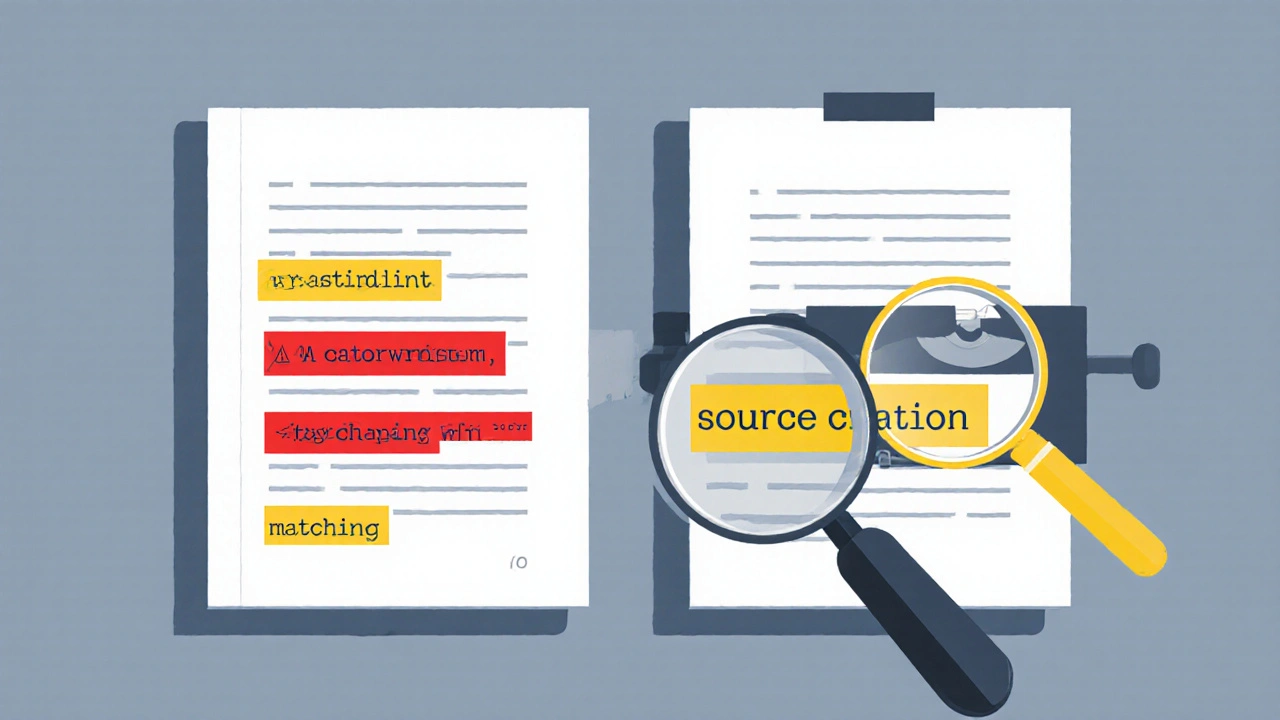
When you submit your essay to Turnitin as a UK student, you’re not just sending in your work-you’re handing over your academic reputation. The report that comes back can feel like a verdict. That green, yellow, or red similarity score? It doesn’t automatically mean you’ve cheated. But if you don’t know how to read it, you could be in trouble. Most students panic when they see a 30% match. Others ignore it entirely. Neither approach works. You need to understand what Turnitin is actually showing you-and what it isn’t.
What Turnitin Actually Measures
Turnitin doesn’t detect plagiarism. It detects text matching. That’s a big difference. It compares your submission to a massive database: published journals, books, websites, past student papers, and even pay-for-essay sites. If a sentence or phrase shows up elsewhere, Turnitin flags it. But that doesn’t mean you copied it. Maybe you wrote it the same way someone else did. Maybe you cited it properly. Maybe it’s a common phrase like “the purpose of this study is.”
Turnitin’s algorithm doesn’t understand context. It doesn’t know if you quoted a source with correct APA formatting. It doesn’t know if you paraphrased with original wording. It just sees strings of words that appear elsewhere. That’s why a 15% similarity score on a 3,000-word essay might be perfectly fine-if it’s from properly cited references. And a 5% score could be dangerous-if it’s from unattributed paraphrasing in your methodology section.
Breaking Down the Report: The Colors and Numbers
When you open your Turnitin report, you’ll see a color-coded bar at the top. Each color means something:
- Green (0-24%): Low match. Usually safe. Common in introductions, definitions, or citations.
- Yellow (25-49%): Medium match. Needs checking. Could be over-reliance on sources or poor paraphrasing.
- Orange (50-74%): High match. Red flag. Likely unoriginal writing or missing citations.
- Red (75-100%): Very high match. Serious concern. Could indicate copying or contract cheating.
But don’t trust the color alone. Look at the breakdown. Click on each highlighted section. Turnitin will show you where the text came from. Is it a textbook you cited? A Wikipedia page you didn’t reference? A past student’s paper from your own university? Each source tells a different story.
Common Misinterpretations UK Students Make
Here’s what most students get wrong:
- “My score is 12%, so I’m fine.” Maybe. But what if that 12% is all from one unquoted paragraph? That’s plagiarism, even if the total is low.
- “I cited everything, so why is it flagged?” Because Turnitin doesn’t know what’s cited. It only sees text. If you wrote “Smith (2023) argues that climate policy fails to address equity,” and Smith’s exact words appear in a journal, Turnitin will highlight it-even if you cited it correctly. That’s normal. You don’t need to change it.
- “I paraphrased, so it shouldn’t show up.” Wrong. If your rewrite still uses the same structure, key phrases, or terminology as the original, Turnitin will catch it. Paraphrasing isn’t just swapping synonyms. It’s restructuring ideas in your own voice.
- “My tutor said 20% is okay.” That’s not a rule. Universities don’t have fixed thresholds. What matters is whether you’ve used sources ethically. A 10% score with no citations is worse than a 40% score with perfect referencing.

How to Fix Problem Areas
So you’ve opened your report and found a section highlighted in orange. What now?
- Check the source. Click the highlighted text. See where it came from. If it’s a source you cited, leave it. No action needed.
- If it’s a source you didn’t cite, you need to either add a citation or rewrite it. Don’t just delete the sentence. Explain the idea in your own words, then cite properly.
- If it’s a common phrase, like “this paper examines…” or “according to the literature,” you can ignore it. Turnitin often flags these. Look for patterns-do multiple small matches add up to a large chunk? That’s a sign you’re relying too heavily on others’ wording.
- If it’s from another student’s paper, that’s serious. It means someone else wrote this before you. Even if you didn’t know it existed, you’re still responsible. Rewrite it entirely.
Here’s a real example: A student wrote, “The rise of social media has transformed communication patterns among teenagers.” Turnitin flagged this because a 2022 journal article said almost exactly the same thing. The student had read the article, remembered the idea, and rewritten it without citing. That’s plagiarism. The fix? “Teenagers now interact more through digital platforms than face-to-face settings, a shift documented by researchers since 2020 (Lee, 2022).” That’s original phrasing + proper credit.
What Turnitin Doesn’t See
Turnitin has blind spots. It won’t catch:
- Paraphrased ideas from sources you didn’t cite
- Plagiarism from non-digital sources (like old books not scanned)
- Copy-pasted images or handwritten text
- AI-generated content unless it matches something already in its database
That’s why your university also uses academic integrity policies and human review. Turnitin is a tool, not a judge. It helps you find problems before your tutor does. But if you’re copying AI-generated text and changing a few words, Turnitin might not catch it-and your tutor will. Always write in your own voice. Use sources to support your thinking, not replace it.

Best Practices for UK Students
Here’s how to use Turnitin reports the right way:
- Submit early. Many UK universities let you submit drafts to Turnitin before the final deadline. Use that. Check the report, fix issues, resubmit.
- Don’t ignore the report. If your tutor gives you feedback based on Turnitin, read it. Don’t assume they’re being harsh-they’re helping you avoid failing.
- Learn your university’s policy. Some universities allow up to 25% similarity if properly cited. Others expect under 10%. Know your rules.
- Use citation tools. Tools like Cite This For Me or EndNote help format references correctly. If your citations are messy, Turnitin might flag them as matches.
- Write first, then cite. Don’t copy and paste while researching. Take notes in your own words. Then go back and add citations later. This builds original thinking.
When to Ask for Help
If you’re confused by your report, don’t guess. Ask your tutor, your academic advisor, or your university’s writing center. Most UK universities have free support services for this exact issue. Bring your Turnitin report with you. Point to the sections you don’t understand. Say: “I’m not sure if this match is a problem.” They’ve seen hundreds of these reports. They’ll tell you what to fix-and what to ignore.
Turnitin isn’t your enemy. It’s a mirror. It shows you where your writing overlaps with others. The goal isn’t to get zero matches. The goal is to make sure every match is honest, credited, and intentional. That’s what academic integrity looks like.
What is a good Turnitin similarity score for UK students?
There’s no universal “good” score. A 10% score with no citations is worse than a 35% score with perfect referencing. What matters is whether the matched text is properly attributed. Most UK universities expect similarity scores under 20-25% when citations are included, but policies vary. Always check your institution’s guidelines.
Can Turnitin detect AI-generated text like ChatGPT?
Turnitin can detect some AI-generated text if it matches content already in its database, but it’s not foolproof. Many AI-written essays don’t match existing sources because they’re original combinations of common phrases. That’s why universities now use separate AI detectors alongside Turnitin. The best defense is writing in your own voice using your own research.
Why does Turnitin flag my references and bibliography?
Because Turnitin compares every word, including citations. If your reference list uses standard formatting (like APA or Harvard), it will match other students’ reference lists. That’s normal. You don’t need to change it. Just make sure the in-text citations are correct and the sources are properly listed.
What should I do if my Turnitin report shows a match to another student’s work?
If you didn’t copy it, rewrite the section in your own words. Even if you found the same idea independently, Turnitin flags it because the wording is too similar. Use your notes, restructure the argument, and explain it differently. Then check again. If you’re unsure, ask your tutor for guidance before resubmitting.
Is it okay to submit the same paper to Turnitin more than once?
Yes, if your university allows draft submissions. Many UK institutions let you submit early drafts to check your similarity score before the final deadline. Each new submission generates a new report. This is a great way to improve your work. Just make sure you’re not submitting the same version multiple times without changes.